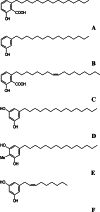Biological activity of phenolic lipids
- PMID: 20213924
- PMCID: PMC11115636
- DOI: 10.1007/s00018-009-0193-1
Biological activity of phenolic lipids
Abstract
Phenolic lipids are a very diversified group of compounds derived from mono and dihydroxyphenols, i.e., phenol, catechol, resorcinol, and hydroquinone. Due to their strong amphiphilic character, these compounds can incorporate into erythrocytes and liposomal membranes. In this review, the antioxidant, antigenotoxic, and cytostatic activities of resorcinolic and other phenolic lipids are described. The ability of these compounds to inhibit bacterial, fungal, protozoan and parasite growth seems to depend on their interaction with proteins and/or on their membrane-disturbing properties.
Figures
References
-
- Kozubek A, Tyman JHP. Resorcinolic lipids, the natural non-isoprenoid phenolic amphiphiles and their biological activity. Chem Rev. 1999;99:1–25. - PubMed
-
- Ross AB, Åman P, Andersson R, Kamal-Eldin A. Chromatographic analysis of alkylresorcinols and their metabolites. J Chromatogr A. 2004;1054:157–164. - PubMed
-
- Ross AB, Kamal-Eldin A, Åman P. Dietary alkylresorcinols: absorption, bioactivities, and possible use as biomarkers of whole-grain wheat- and rye-rich foods. Nutr Rev. 2004;62:81–95. - PubMed
-
- Fardet A, Rock E, Remesy C. Is the in vitro antioxidant potential of whole-grain cereals and cereal products well reflected in vivo? J Cereal Sci. 2008;48:258–276.
-
- Bondia-Pons I, Aura AM, Vuorela S, Kolehmainen M, Mykkanen H, Poutanen K. Rye phenolics in nutrition and health. J Cereal Sci. 2009;49:323–336.
Publication types
MeSH terms
Substances
LinkOut - more resources
Full Text Sources
Medical


